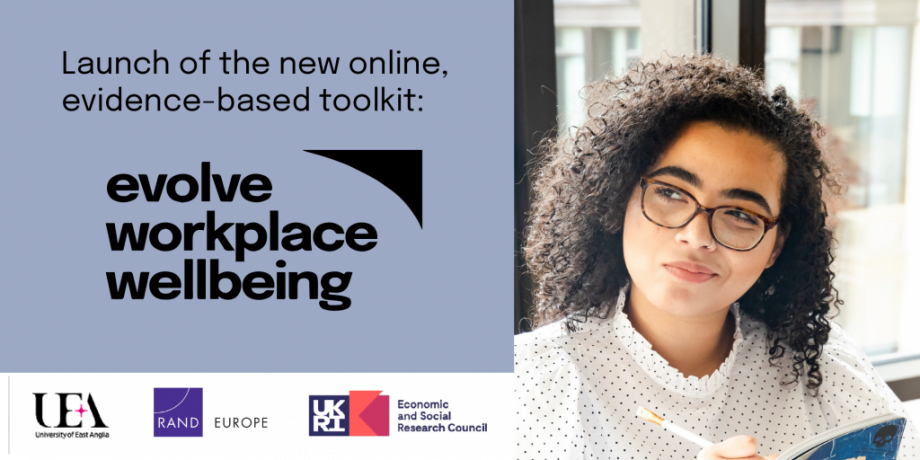It is part of a new web-based toolkit of free, evidence-informed workplace wellbeing resources, drawing on cutting edge research from the University of East Anglia (UEA) and RAND Europe, as well as insider insights, so that businesses can take action to help themselves evolve and thrive.
A key feature of the ‘Evolve Workplace Wellbeing’ website, the calculator is an interactive tool which demonstrates the financial savings that could be associated with different kinds of workplace initiatives via improved employee wellbeing and boosts to productivity.
Employers can enter figures and characteristics about their business and, as far as possible, the calculator gives benefits and costs in pounds and pence, allowing a direct comparison to help decision-making.
Dr Helen Fitzhugh, of the Workplace Wellbeing research team at UEA’s Norwich Business School, said: “This resource, particularly the cost effectiveness calculator, helps employers build a business case internally for wellbeing initiatives in the workplace. Hopefully it will be of interest to HR departments, small businesses, as well as employer bodies. Ultimately it’s about showing how improving wellbeing has benefits for both staff and employers.”
The calculator allows employers to choose from a range of initiatives which aim to encourage healthy behaviours, such as: alcohol or smoking reduction, improved physical fitness, healthier eating, & health checks; and others which aim to support mental health and wellbeing, such as mindfulness apps, financial wellbeing, and workplace volunteering.
It shows the estimated wellbeing effects that might arise in a workplace that offers the selected intervention. This includes the benefits per employee of improved physical or mental health and job satisfaction.
It will also estimate the value to the business of any improvements to productivity that arise due to reduced absenteeism or presenteeism per employee.
The wellbeing and productivity benefits will depend on whether employees are aware that their employer provides these initiatives, and also on how widely used they are within the organisation.
The tool allows the user to see what benefits may arise if there is greater awareness of the initiative and will provide details of which sorts of programmes are typically more effective.
The calculator has been developed using insights from Britain’s Healthiest Workplace Survey, and analyses conducted by Dr Ritchie Woodard and Prof Sara Connolly at UEA, and Dr Emike Nasamu at the University of Chester, in collaboration with Dr Martin Stepanek at insurance and investments company Vitality and Will Phillips at RAND Europe.
Dr Stepanek, Lead Researcher at the Vitality Research Institute, said: “Whilst our understanding of the importance of employee health to productivity and engagement continues to improve, what is less well understood is how to translate these benefits into pounds and pence, so that employers can build a business case for further investing in employee health.
“This new tool bridges the gap between the theory and the practice, allowing employers to quantify the significant financial benefits of investing in employee health, creating an ability to develop long-term strategies that have the potential to transform employee wellbeing.”
The Evolve Workplace Wellbeing website is based on the outcomes of a research project funded by the Economic and Social Research Council called Practices for Health and Wellbeing at Work, led by Prof Kevin Daniels from UEA. The website distils the findings into a useful and practical resource for employers and practitioners.
Prof Daniels said: “The UEA team’s collaboration with RAND Europe has focused on identifying what good organisational practice looks like, but also how organisations sustain and evolve those practices that comprise strategic and innovative approaches to employee health and wellbeing.”
RAND Europe executive vice president Chris van Stolk said: “A key objective of this project was to provide actionable, evidence-based tools and information that can help organisations to best support their employees.
“Through partnering with the UEA we’ve been able to develop this calculator and a number of other valuable resources that will make a difference to workplace health, wellbeing and productivity.”
There are different resources available depending where on the workplace wellbeing journey businesses are, whether they are new to thinking about it or have already evolved a sophisticated wellbeing approach.
It offers the latest workplace wellbeing insights via podcasts, and recordings of seminars and events, as well as a free online course with videos and case studies, and opportunities to network and take part in further research.



